|
Recurrent flash floods in areas surrounding
Nullah Lai, Rawalpindi, Pakistan

Manzoor Butt
Correspondence:
Dr Manzoor Ahmed Butt
Freelance
Writer and Doctor
Rawalpindi
Pakistan
Email: drmanzoor@ymail.com
Website:

Introduction
Nullah Lai, also called Nalla Lai
is a rain water fed natural stream
flowing through the city of Rawalpindi.
Every year during monsoon season (July
to September) it floods after heavy
rains in its catchment basin in the
Margalla hills in Islamabad. It has
a catchment area of 234.8 km2, extending
from Margalla Hills in Islamabad to
the twin cities of Islamabad and Rawalpindi.
[1] This stream / Nullah passes through
different localities of the twin cities
and turns steeper with many cascades
finally entering in the Soan River,
which is a tributary of the mighty
river Indus.
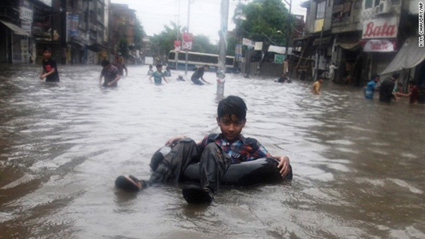
Children playing in flood water
Background
Monsoon rain is an every year usual
and expected feature in most of Pakistan,
especially in Rawalpindi. The Lai
Nullah Basin receives heavy rainfall
averaging 500 mm in the monsoon season,
which normally leads to heavy flood
discharge. During the last 60 years
(1944 to 2004) a total of 19 flood
events had occurred.[1] Extreme flood
years were 1981, 1988, 1997 and 2001,
the latter having been the largest
among the recorded events. On July
23, 2001, an unprecedented rainfall
occurred over Islamabad-Rawalpindi
resulting in 620 mm of rain in a span
of about 10 hours. [1]The intensity
and amount of rainfall caused the
water level of Nullah Lai and its
tributaries to rise. The flood had
caused the worst damage in Rawalpindi.
A total of 74 human lives were lost,
about 400,000 people were affected,
742 cattle head perished, 1,087 houses
were completely and 2,448 partially
damaged. Estimates indicate a damage/loss
of more than USD 0.25 billion to infrastructure,
Government and private property.[1]
Flash flood in Nullah Lai, September,
2014:
On this 4th September, continuous
heavy rain started in the twin cities.
A flood warning was issued on 5th
September. 286 mm rainfall was recorded
in Rawalpindi and 278 mm in Islamabad
just in one day. This rainfall inundated
several low-lying areas. The water
entered several homes located near
the Nullah. The water level in Nullah
Lai touched the maximum point of 18
feet at Katariyan and 11 feet at Gawalmandi
- the two most dangerous points of
Lai in Rawalpindi because of very
close proximity of population density
along its banks. The water level in
Soan River broke the record of 22
years.
Major factors that aggravate recurrent
flash floods in Nullah Lai:
This type of flood is seasonal. The
situation could be very well anticipated
mostly 10 to 12 hours before it happens
but unfortunately action starts after
the damage. When the water level starts
rising in the initial stage children
start swimming and enjoying without
thinking of more water that is coming
from the catchment basin. The following
are the main aggravating factors of
flash floods.
- The meteorology department predicted
less rainfall for this monsoon season.
As usual, the prediction turned out
false in the first week of September
and there was very heavy rain on 4th
and 5th September.
- The flood commission does not take
necessary steps to handle the flood
situations.
- Lack of will to solve and address
such situation on part of both the
local residents and government.
- Absence of local government of people's
own representatives.
- Encroachments along the banks of
Nullah Lai throughout its course by
local residents and land developers.
- Because of improper waste disposable
and poor sewerage system of the city,
people dump solid waste, human and
animal excreta in Lai.
- No pre monsoon season cleaning and
excavation of dumped solid waste in
Lai Nullah to widen and deepen it.
- Non cooperative behavior of residents
towards flood warnings. At many times,
police and army have to be called
in for forced evacuation of local
residents.
- Non availability of reservoirs or
small dams to store this rain water
during monsoon. The government does
not have any policy to work on this
aspect.
What is the solution?
With proper planning and due anticipation,
it is very much possible to avoid
/ lessen harmful and destructive effects
of these seasonal flash floods. Since
my early childhood, I am a witness
to destruction caused by Lai in Rawalpindi.
Things have not changed much and still
after seventy years, there is no planning
to address these issues. There is
also no accountability of peoples
responsible for mismanagement and
mishandling of these seasonal floods.
Pakistan army is the main institution
that plays the most vital part in
rescue operations and helps every
victim without fear of risks to their
own lives. Their boats and helicopters
remain busy round the clock until
the operations are over. Rescue 1122
is also an emerging institution that
provides dedicated free volunteer
rescue and relief services to flood
victims.
Recommendations for future:
Experts expect more severe floods
in 2015 and 2016 due to climate changes
in local, regional and global levels.
Pakistan has a climate change policy
but there is no minister to implant
it. If we intend to prevent and reduce
the losses of lives and properties,
we have to undertake the following
measures with full will and commitment;
1) There is an urgent need
to work out policies to address the
urban flash floods.
2) The radar system of meteorology
department needs upgrading to avoid
false predictions.
3) Capacity of flood commission
needs to be enhanced for playing a
more proactive role.
4) Pre monsoon cleaning of
Nullah Lai to deepen and widen it
so that it could accommodate more
flow of water.
5) Establishment of a proper
system of disposal of solid waste,
human and animal excreta through people's
elected local representatives. There
should be strict legislation for illegal
disposal of solid waste, human and
animal excreta in Nullah Lai.
6) The most important issue
of illegal encroachments along the
banks of Lai should be addressed through
people's local elected representatives.
It is not an easy issue and needs
strong political will and legislation.
7) The Japan International
Cooperation Agency (JAICA) gave a
grant of $5.5 million to set up a
high tech flood early warning system
on the Lai Nullah. Educating the local
communities through their local elected
representatives to respond timely
to flood warning alarms is of the
utmost importance. People do not bother
to respond to these alarms and it
is usual practice to call army and
police for forced evacuation.
8) Safety first: Immediately
after rain, there is always hazard
of electric current from fallen polls
and naked wires. Immediate action
to shut off power and restore the
normal situation can prevent loss
of lives.
9) Risk of diarrhea, dengue,
malaria, other fevers like typhoid
and skin infections should be prevented
by timely vaccination of humans and
livestock as well as prompt treatment.
10) Building of reservoirs
or small dams to store this rain water
during monsoon. This will give added
benefit of power generation if used
wisely.
11) With a definite and well
planed system it is also possible
to decrease carbon emission and increase
forest plantation on the banks of
Nalla Lai and alongside the small
reservoirs.
12) The most important and
environmental friendly initiative
should aim to keep this stream clean
by avoiding dumping solid waste and
human and animal excreta. There was
a time when this stream was clean
and people use to swim in it. This
is still possible.
Photo essay
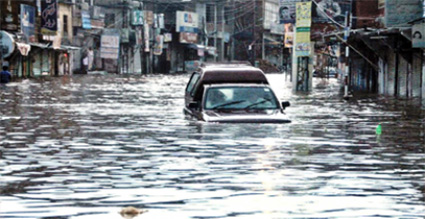
Flood 2014
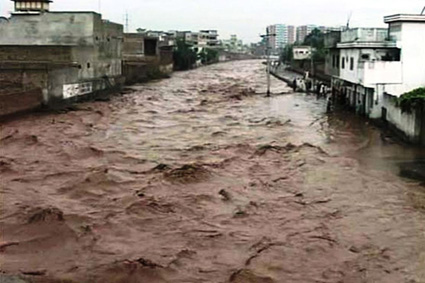
Encroachments along Lai
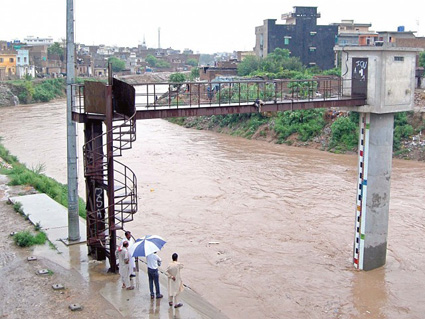
Flood warning station
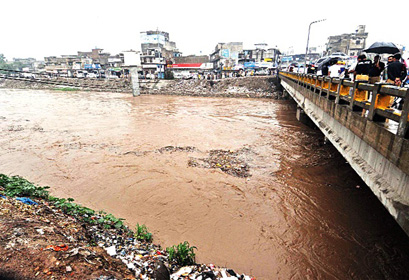
People watching rising level in Lai

Waste dumps along Lai
References
1) Strengthening of Flood Risk Management
in Lai Nullah Basin,
http://www.jica.go.jp/project/english/pakistan/0700597/01/01.html
2) Lai Nullah - Extreme Flood Years
http://www.apfm.info/pdf/case_studies/cs_pakistan_nullah.pdf/
|